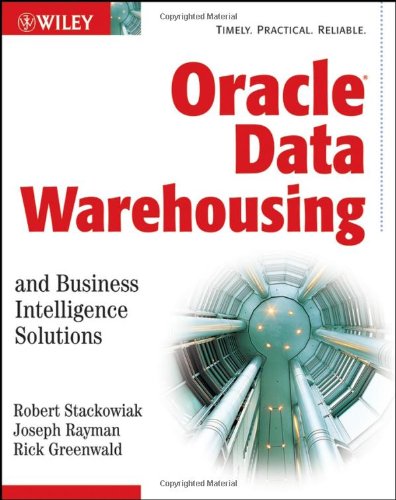Robert Stackowiak, Joseph Rayman, Rick Greenwald9780471919216, 0471919217
Table of contents :
Oracle® Data Warehousing and Business Intelligence Solutions……Page 1
Contents……Page 10
Acknowledgments……Page 16
Introduction……Page 18
Part I: Oracle Business Intelligence Defined……Page 19
Part II: Custom-Built Data Warehousing Solutions……Page 20
Part III: Best Practices……Page 21
From Here……Page 22
Part I: Oracle Business Intelligence Defined……Page 24
Oracle Business Intelligence……Page 26
Business Intelligence and Transactional Applications……Page 27
Daily Business Intelligence……Page 28
Balanced Scorecard……Page 29
Enterprise Planning and Budgeting……Page 31
Oracle Integration Components Enabling Business Intelligence……Page 32
Business Activity Monitoring……Page 33
Enterprise Messaging Service……Page 34
Custom Data Warehouse Solutions……Page 35
The Role of the Oracle Database……Page 37
Oracle Warehouse Builder……Page 38
Oracle Business Intelligence Standard Edition……Page 39
Oracle Business Intelligence Enterprise Edition……Page 41
Oracle Portal……Page 43
Spreadsheet Add-ins……Page 44
Building Custom Business Intelligence Applications……Page 46
Emerging Trends……Page 47
Oracle’s Transactional Business Intelligence……Page 50
Business Terminology……Page 51
Oracle’s Daily Business Intelligence……Page 53
How DBI Works……Page 56
Varieties of DBI……Page 57
Balanced Scorecards……Page 68
Oracle Balanced Scorecard Structure……Page 69
Creating an Oracle Balanced Scorecard……Page 71
The Oracle Customer Data Hub……Page 72
Other Oracle Data Hubs……Page 74
Is Transactional Business Intelligence Enough?……Page 75
Introduction to Oracle Data Warehousing……Page 76
Oracle Data Warehousing Basics……Page 77
Oracle Database Analysis and Schema Considerations……Page 78
Managing an Oracle-based Data Warehouse……Page 87
Where to Start?……Page 93
Oracle/PeopleSoft EPM……Page 94
Oracle/Siebel Business Analytics Applications……Page 96
Choosing Completely Custom……Page 97
Choosing a Platform……Page 98
Scaling Up Platforms Versus Scaling Out……Page 99
Hardware Platforms……Page 100
Availability Considerations……Page 103
Manageability Considerations……Page 106
Sizing the Platform……Page 107
Information Needed for Warehouse Hardware Sizing……Page 108
Benchmarking……Page 109
Sizing Hardware for Business Intelligence Tools……Page 112
Your Strategy……Page 113
Part II: Custom-Built Data Warehousing Solutions……Page 114
Designing for Usability……Page 116
Key Design Considerations……Page 117
Features for Design — Enhancing Performance……Page 121
Business Scenario……Page 129
Normalized Design……Page 131
Dimensional Design……Page 133
Hybrid Design……Page 136
Online Analytical Processing Design……Page 139
Other Considerations……Page 143
Selecting the Best Approach……Page 149
Business Intelligence Tools……Page 150
Oracle Portal and Portal Products……Page 151
Using Oracle Portal……Page 152
Building and Deploying Oracle Portal and Portlets……Page 155
Reporting……Page 159
BI/XML Publisher……Page 160
Oracle Reports……Page 163
Oracle BI Reporting Workbench (Actuate)……Page 164
Ad hoc Query and Analysis……Page 165
Business Intelligence Enterprise Edition……Page 166
Discoverer and Business Intelligence Standard Edition……Page 176
Oracle Spreadsheet Add-ins……Page 185
Building Business Intelligence Applications……Page 188
Data Miner……Page 189
Other Tools……Page 192
Data Loading……Page 198
Oracle Database Data Loading Features……Page 199
Embedded ETL in the Oracle Database……Page 200
SQL*Loader……Page 201
Change Data Capture……Page 202
Data Pump……Page 203
OWB Packaging……Page 204
Typical Steps when using OWB……Page 205
ETL Design in OWB……Page 207
OWB and Dimensional Models……Page 212
The OWB Process Editor……Page 214
Balancing Data Loading Choices……Page 215
Managing the Oracle Data Warehouse……Page 218
Oracle Enterprise Manager Grid Control……Page 219
Database Performance Monitoring……Page 223
Database Administration……Page 225
Database Maintenance……Page 241
Database Topology……Page 246
Management and Management Options……Page 247
Data Warehouse Performance Tuning and Monitoring……Page 250
Who Is Responsible?……Page 251
Causes of Poor Performance……Page 254
Successful Approaches to Performance Tuning……Page 261
Critical Tasks for Performance Tuning Lifecycle……Page 262
Hardware Configuration……Page 267
Software Configuration……Page 270
Database Application Design……Page 279
Where To Start……Page 280
Enterprise Manager Advisory Framework……Page 281
Approaches for Success……Page 296
Part III: Best Practices……Page 298
Scoping the Effort and an Approach for Success……Page 300
Where to Start……Page 301
Information Sources……Page 303
Accountability and Securing Business Sponsorship……Page 305
Project Review Board……Page 306
Choices of Methodologies……Page 307
A Business-focused Approach……Page 308
Organization Structure……Page 316
End-User Experience……Page 322
Communication — Managing Expectations……Page 324
Contingency Allocation……Page 325
Financial Risk……Page 326
Technology Risk……Page 327
No Place to Shortcut……Page 328
Understanding Business Needs……Page 330
Independent Data Marts……Page 331
Limited and Inflexible Reporting……Page 333
Limited Data History……Page 334
Lack of Current High-Quality Data……Page 335
Limited Growth Flexibility……Page 336
Financial Companies……Page 337
Healthcare……Page 339
Manufacturing……Page 341
Retail……Page 342
Telecommunications……Page 343
Educational Institutions……Page 344
Government Agencies……Page 346
Developing Scope and Gaining Business Support……Page 349
Justifying Projects and Claiming Success……Page 352
Where to Start Justification……Page 353
Measuring Value……Page 354
Common Metrics to Measure……Page 355
Common Budgeting Techniques……Page 372
Total Cost of Ownership……Page 379
Modeling Total Cost of Ownership……Page 380
Modeling Return on Investment……Page 383
Claiming Success……Page 386
Index……Page 388







Reviews
There are no reviews yet.